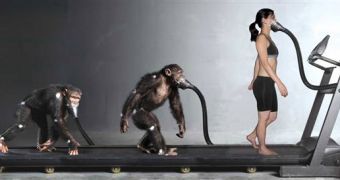When humans stopped using their hands for walking, everything they did was better, from foraging to sex. But what a new research shows is that they did it because walking on two feet is less exhausting than "knuckle-walking" on all four, like chimps and gorillas do. Humans walking on two legs waste just a quarter of the energy consumed by chimps for walking around.
"Walking upright on two legs is a defining feature that makes us human. It distinguishes our entire lineage from all other apes." said lead researcher Herman Pontzer, an anthropologist at Washington University in St. Louis.
Saving energy through bipedalism (walking upright) was a great advantage when competing for resources. This is a new hypothesis on the origin of bipedal walking. Recent researchers point out that, rather than transitioning for millions of years from a hunched position as commonly thought, our remote ancestors could already walk upright when they descended from the trees.
The research team trained five chimps to walk both upright and on fours on a treadmill. They wore masks, assessing energy consumption by how much oxygen was consumed during the exercise. Four humans walking upright on the treadmills were used for comparison.
At similar weight, humans consumed just 25 % of the energy burnt by the chimps. Chimps appeared to employ the same energy amount by walking on two legs as on four. Still, one chimp with a longer stride was more efficient in energy consumption when walking upright.
Chimps performed differently linked to the length of their stride and the muscle amount employed with each step. Chimps were also measured for energy consumption while walking across a metallic force plate. "It's basically an expensive bathroom scale. It measures how much force is being applied by the limb to the ground." said Pontzer.
Biomechanical equations say that energy consumption rises with shorter steps or more active muscle mass. Humans got their economic gait through relatively long legs and modified pelvic structures.
"What [our] results allow us to do was to look at the fossil record and see whether fossil hominids show adaptations that would have reduced bipedal energy expenditures. We and many others have found these adaptations [such as slight increases in hind limb extension or length] in early hominids, which tells us that energetics played a pretty large role in the evolution of bipedalism." said study team member David Raichlen of the University of Arizona.
The theory that bipedalism evolved on the ground is challenged by new findings in wild orangutans, which often stand upright to balance on thin branches and the muscles gibbons employ for climbing and swinging through the forest canopy are also used for running on two legs.

 14 DAY TRIAL //
14 DAY TRIAL //